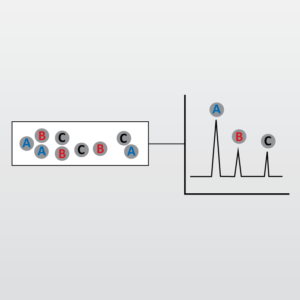High Performance Liquid Chromatography (HPLC)
Home » Our Techniques » Chromatography » HPLC
High Performance Liquid Chromatography (HPLC) and Ultra High Performance Liquid Chromatography (UPLC) are analytical techniques that utilize a compound’s intrinsic affinity for both a “mobile phase” (typically a buffered solvent) and a “stationary phase” (porous solid support with specialized coating). A pump is used to provide a continuous flow of a solvent into which a dissolved sample is introduced. Once the dissolved sample is introduced, it travels through an analytical column containing the stationary phase, and analytes within the dissolved sample mixture are then separated, depending on their affinity to the coated particles in the column. After the components in the sample are separated, they may pass through an assortment of detectors. The detector response and the “retention time” (time it takes for a compound to pass from the injector to the detector) of the compound(s) of interest may then be compared to a reference material. UPLC improves upon HPLC with enhanced peak resolution and throughput.
EAG maintains an inventory containing over 250 columns spanning reverse phase (i.e. C8 and C18), normal phase (i.e. hydrophilic interaction liquid chromatography (HILIC)), phenyl-hexyl, cyano and specialty columns for carbohydrates, sugars, free fatty acids, proteins, organic acids, etc. We can usually obtain specialty columns within a few business days of project initiation.

In addition, a number of detection techniques may be utilized to analyze for a specific type of compound.
- Spectrophotometric Detection (UV-Vis)
- Fluorescence Detection (FLD)
- Evaporative Light Scattering Detection (ELSD)
- Electrospray Ionization-Ion Trap Mass Spectrometry Detection (ESI-IT-MS)
- Atmospheric Pressure Chemical Ionization-Ion Trap Mass Spectrometry Detection (APCI-IT-MS)
- Refractive Index Detection (RI)
Ideal Uses of HPLC
- UV-Vis, fluorescence detection (FLD) and evaporative light scattering detection (ELSD) allow for detection of a broad range of analytes with comparison to reference standards.
- Quality assurance and control
- Quantitative and purity analysis of the following example analytes:
- Amino acids
- Antibiotics
- Cannabinoids and cannabidiol (CBD) containing products
- Capsaicinoids
- Dyes
- Hydrocarbons
- Nucleic acids
- Organic acids
- Such as acetic, oxalic, formic, malic, ascorbic, maleic, fumaric and succinic acids.
- Pesticides
- Polymer extractables/leachables
- Bisphenol A, Irganox, Cyanox, Cyasorob and plasticizers.
- Proteins
- Steroids
- Modified celluloses/carbohydrates, sugars and sweeteners
- Sugars and sweeteners such as lactose, sucrose, glucose, sorbitol, sucralose, acesulfame potassium, saccharin sodium and aspartame
- Viscosity and thickening agents such as hydroxypropyl methylcellulose (hypromellose, HPMC), hydroxypropyl cellulose (HPC), methylcellulose
- Sunscreen and cosmetic additives
- Benzophenone
- Octocryelene
- Ethylenediaminetetraacetic acid (EDTA)
- Other organic and inorganic substances
- Formaldehyde
- Buckminsterfullerene (Buckyballs, C60)
- Biocides/preservatives
- Quaternary ammonium chloride compounds (QACs)
- Benzalkonium chloride (BZK)
- Butylated hydroxytoluene (BHT)
- Polyquats
- Parabens
- Tocopherols
- Sodium benzoate
- Quaternary ammonium chloride compounds (QACs)
- Sample matrix examples:
- Pharmaceutical, cosmetic, and dietary/nutrition products (i.e. cream, gel, ointment, shampoo, oral suspension, ophthalmic suspension, tablet, capsule, softgel)
- Environmental (i.e. soil, water, sediment)
- Biological (i.e. crops, livestock tissues, milk, eggs, blood, urine)
- Industrial (i.e. packaging, cleaning products, chemical products, raw materials)
- Food (i.e. beverages, fruits, vegetables meat products, baked goods and other processed sources)
- Other surfaces (i.e. electronics)
Strengths
- Effectively separates molecules of similar structure
- Precise and highly reproducible quantitative results
- Applicability to diverse analytes
- High sensitivity
- Highly reproducible assays
- UPLC: Faster analysis with improved resolution
Limitations
- Compounds must be soluble in common solvents such as water, alcohols, and acetonitrile
- Pump pressure is limited to 40 MPa (HPLC) and 100 MPa (UPLC)
- Cannot separate inorganic ions
- Lack of an ideal universal detector
- Aggressive non-polar solvents are not compatible with the instrument
Technical Specifications
- Sample injection volume: 1-100 uL
- Column compartment temperature: 5-110°C
- pH range: 1-12.5
- Detection
- UV/Vis (190-800 nm)
- Fluorescence
- ELSD
Would you like to learn more about using High Performance Liquid Chromatography?
Contact us today for your High Performance Liquid Chromatography (HPLC) needs. Please complete the form below to have an EAG expert contact you.